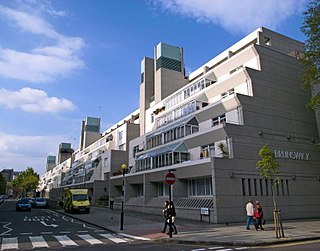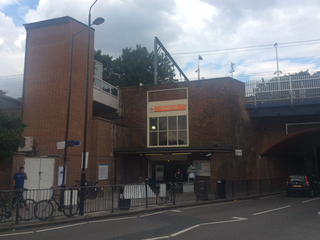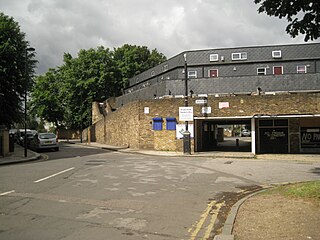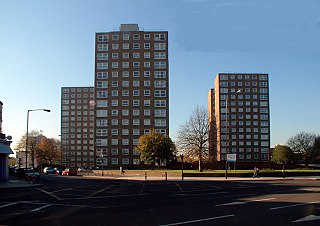
The Dunboyne Road Estate [1] previously known as the Fleet Road Estate is a Grade II-listed modernist estate, designed in Gospel Oak, London by Neave Brown in the late 1960s. [2]

The Dunboyne Road Estate [1] previously known as the Fleet Road Estate is a Grade II-listed modernist estate, designed in Gospel Oak, London by Neave Brown in the late 1960s. [2]
The scheme was designed by Neave Brown and the Camden Architects Department, it was the first application of the low-rise high-density housing scheme attached to public building. There were built in 1967, as an experiment where 71 houses, a shop, and a studio, were arranged in parallel terraced rows, in groups of eight or sixteen, following the split level principles that Brown had used in his small housing scheme in Winscombe Street. Each house had a large terrace which overlooked the communal gardens. [3]
No 36 Dunboyne Road retains many of it original features. It is a split level two bedroomed maisonette. The sitting room and study are on the split level, with large sliding French windows leading onto a paved terrace. Details include: full storey height doors; a tiled concrete kitchen worktop with timber built in cupboards and drawers; stairs in a glazed stairwell and stairs between the split level living areas; the sliding partition between the living area and study allows the residents to configure their living space. [3]

Kentish Town is an area of northwest London, England in the London Borough of Camden, immediately north of Camden Town. Less than four miles north of central London, Kentish Town has good transport connections and is situated close to the open spaces of Hampstead Heath.

Gospel Oak is an inner urban area of north west London in the London Borough of Camden at the very south of Hampstead Heath. The neighbourhood is positioned between Hampstead to the north-west, Dartmouth Park to the north-east, Kentish Town to the south-east, and Belsize Park to the south-west. Gospel Oak lies across the NW5 and NW3 postcodes and is served by Gospel Oak station on the London Overground. The North London Suburb, Gospel Oak, has many schools around it.

The Brunswick Centre is a grade II listed residential and shopping centre in Bloomsbury, London, England. It is located between Brunswick Square and Russell Square and is administratively in the London Borough of Camden.

Gospel Oak railway station is in the London Borough of Camden in north-west London. It is on the North London line (NLL) and is also the western passenger terminus of the Gospel Oak to Barking Line – known informally as GOBLIN. Passengers using Oyster cards are required to tap on interchange Oyster card readers when changing between the two lines. The station is in Travelcard Zone 2, and is managed by London Overground which runs all passenger trains at the station.
The year 1978 in architecture involved some significant architectural events and new buildings.

The Holly Lodge Estate is a housing estate in Highgate, north London.
Arden is a medium-sized housing estate on the south-western edge of the city of Glasgow, Scotland. The M77 motorway runs directly to the west of the neighbourhood, with Junction 3 serving the area; a small industrial estate is located to the south-east. The residential area of Carnwadric is to the north-east of Arden, and the Jenny Lind part of Deaconsbank to the south, while the land to the north is open ground and woodland.

Dartmouth Park is a district of north west London in the Borough of Camden, 6.0 km (3.7 mi) north of Charing Cross. The area adjoins Highgate and Highgate Cemetery and Kentish Town. Parliament Hill is to the west.

The Golden Lane Estate is a 1950s council housing complex in the City of London. It was built on the northern edge of the City, on a site devastated by bombing during the Second World War. Since 1997, the estate has been protected as a group of listed buildings of special architectural interest.

Regent's Park Estate is a large housing estate in the London Borough of Camden. The estate consists of nearly 2,000 homes across 49 buildings and lies on either side of Robert Street, between Albany Street and Hampstead Road. It is immediately to the east of the Regent's Park estate owned by the Crown Estate. The estate includes the sites of Cumberland Market, Munster Square and Clarence Gardens.

The Alton Estate is a large council estate situated in Roehampton, southwest London. One of the largest council estates in the UK, it occupies an extensive area of land west of Roehampton village and runs between the Roehampton Lane through-road and Richmond Park Golf Courses.

The Alexandra Road estate is a housing estate in the London Borough of Camden, North West London, England. It was designed in a brutalist style in 1968 by Neave Brown of Camden Council's Architects Department. Construction work commenced in 1972 and was completed in 1978. It is constructed from site-cast, board-marked white, unpainted reinforced concrete. Along with 520 apartments, the site also includes a school, community centre, youth club, heating complex, and parkland.

Spa Green Estate between Rosebery Avenue and St John St in Clerkenwell, London EC1, England, is the most complete post-war realisation of a 1930s radical plan for social regeneration through Modernist architecture. Conceived as public housing, it is now a mixed community of private owners and council tenants, run by a resident-elected management organization. In 1998 this work by the architect Berthold Lubetkin received a Grade II* listing for its architectural significance, and the major 2008 restoration brought back the original colour scheme, which recalls Lubetkin's contacts with Russian Constructivism.
Regent Estate is a housing estate in Haggerston in the London Borough of Hackney. The estate is named in reference to the nearby Regent's Canal, which was commissioned by the Prince Regent who later became King George IV. It is adjacent to, but distinct from, the Regents Court Estate.
Neave Brown was an American-born British architect and artist. He specialized in modernist housing. Brown is the only architect to have had all his UK work listed: row houses in Winscombe Street, the Dunboyne Road Estate and Alexandra Road Estate, all located in Camden.

Myatt's Fields South is a social housing estate located between Brixton Road and Camberwell New Road in South London. It is on land that once formed part of the Lambeth Wick estate.

The Ledbury Estate is a large estate of social housing, in Peckham in the London Borough of Southwark. The estate is just south of the Old Kent Road, part of the A2 4 kilometres (2.5 mi) from both Tower Bridge and the Elephant & Castle it is adjacent to land used by George Livesey for the South London Gasworks.

Winscombe Street refers to a terrace of five houses in Camden, London, England, designed by the architect Neave Brown for himself and a collective of four other families. It is Grade II listed and was the precursor for the house and maisonette designs used in Dunboyne Road Estate and Alexandra Road Estate.
Peter Tábori is a Hungarian-born British architect. He trained in London and is best known for the housing schemes he designed for the London Borough of Camden under Sydney Cook in the 1960s and 1970s, especially Highgate New Town (1968–1979).

Primrose Hill is a district in the London Borough of Camden, England. Electorally, it is mainly within the Camden Town with Primrose Hill ward, though some other wards do overlap.